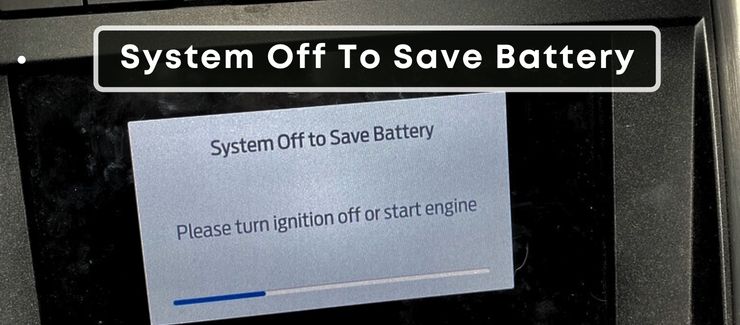Ford System Off To Save Battery Reset
If none of the above works, you’ll need to check the components in the charging system, such as the battery, battery terminals, alternator, etc.
Generally, the System Off To Save Battery message appears when you put the vehicle into accessory mode for too long, causing the battery to get low.
However, I’ve also seen it to be triggered due to some fault in the battery, alternator, or wiring connections.
How to Fix Ford System Off To Save Battery Message?
In this post, we’ll discuss why these issues trigger the System Off To Save Battery message and how you can fix them.
1. Take the Vehicle Out of Accessory Mode
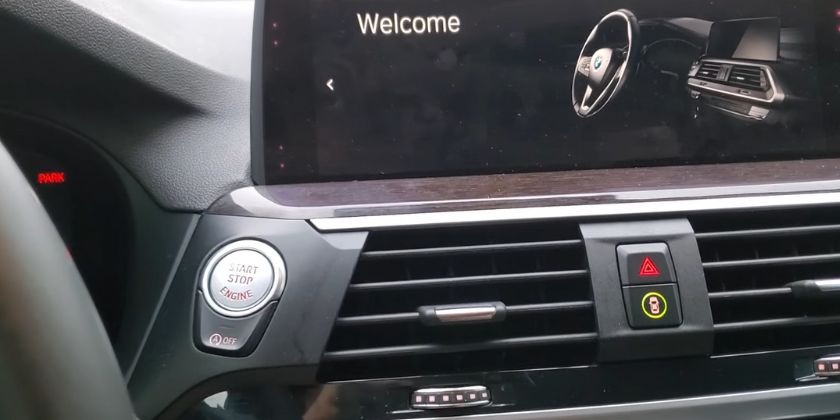
The most plausible explanation for the System Off To Save Battery is that you’ve put the vehicle in the accessory mode for too long and turned on different accessories in that time, causing the battery’s voltage level to drop.
When the ignition key is in the ACC or ON position, you can run different accessories of the vehicle, such as A/C, power windows, infotainment system, etc., without starting the engine.
Since the alternator is not running at that time (due to the engine being off), all of those accessories are powered by the battery.
If you keep running those accessories with the engine off, the battery will soon drain completely (since the alternator is not replenishing the battery).
This situation can potentially be catastrophic as you need the battery voltage level to be healthy.
A low-voltage battery won’t be able to energize the starter motor the next time you turn the ignition key to the ON position, and the vehicle won’t start – potentially leaving you isolated at a deserted location.
Therefore, the System Off To Save Battery is a message generated by the Battery Management System (BMS) to tell you to start the engine.
The BMS also turns off all of the running accessories to preserve the power for the next time you start the engine.
Upon starting the engine, the alternator will turn on and recharge the battery (provided you drive for at least 30-40 minutes) to make up for the power it lost during the starting process and in the accessory mode earlier.
2. Unhook the Battery Cables Temporarily
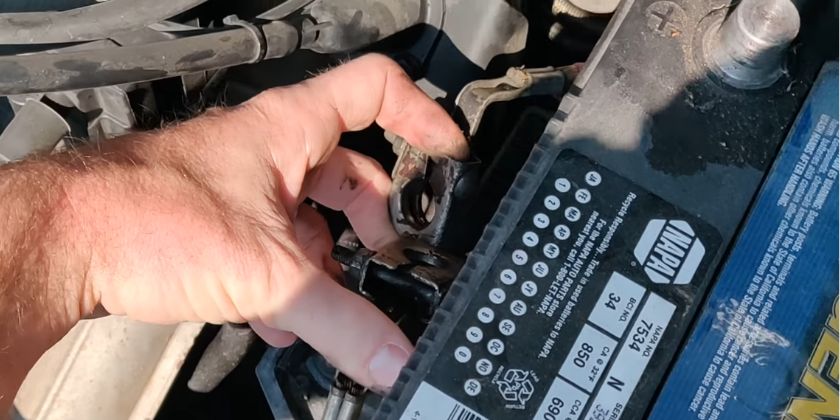
If you’re getting the System Off To Save Battery message even when you haven’t put the vehicle into ACC mode, it’s possible that the ECU is glitching.
It’s a very common problem and usually happens during the winter season, leading the Ford owners to believe that there’s something wrong with their vehicle.
As for the fix, you’ll have to reset the ECU by disconnecting the cables on battery terminals temporarily.
Here’s what you need to do:
- Turn off the vehicle.
- Disconnect the negative battery terminal cable.
- Disconnect the positive battery terminal cable.
- Touch both cables to each other.
- Leave the cables disconnected and wait for 5-6 minutes.
- Connect the positive cable to its terminal.
- Connect the negative cable to its terminal.
3. Reset the Battery Management System
Although I haven’t personally experienced this, many Ford owners claim that sometimes the battery management system glitches and triggers the System Off To Save Battery message even when there’s no issue.
If that’s the case, you can easily verify it by resetting this system.
Here’s how you can do it:
- Turn the ignition on.
- Flash the brights five times.
- Press and release the brake pedal three times.
- The battery light will flash on the instrument panel after 10 seconds, indicating that the BMS has reset.
For more information, you can check out the above video.
4. Check the Battery Voltage
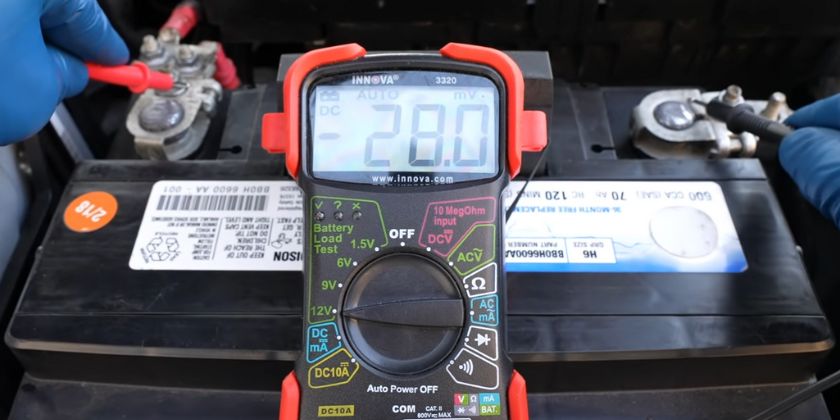
If you’ve followed all the methods mentioned above, but the message is still there, it indicates a hardware malfunction.
To check whether that’s true, the first thing we’ll do is test the battery voltage with a multimeter.
Here’s a brief overview of this process:
- Turn off the vehicle.
- Set the multimeter to Voltage mode at 20V.
- Connect the black multimeter probe to the negative battery terminal.
- Connect the red multimeter probe to the positive battery terminal.
- If the voltage reading is below 12.2V, the battery is not working properly.
At this point, many people wrongly assume that just because the battery voltage is low, it should be replaced (unless it’s 10.5V, which means one of the battery cells is dead).
While it’s true that a low voltage is a sign of a dying battery, it can also happen due to other reasons, such as loose/corroded terminals, a faulty alternator, or a parasitic draw.
So, the first thing you need to do is to check the battery terminals.
Make sure the connections are tight. And if there’s corrosion, apply baking soda over the terminals and scrap it with a brush.
After that, test the battery again, following the same steps we discussed above.
5. Check For A Parasitic Draw
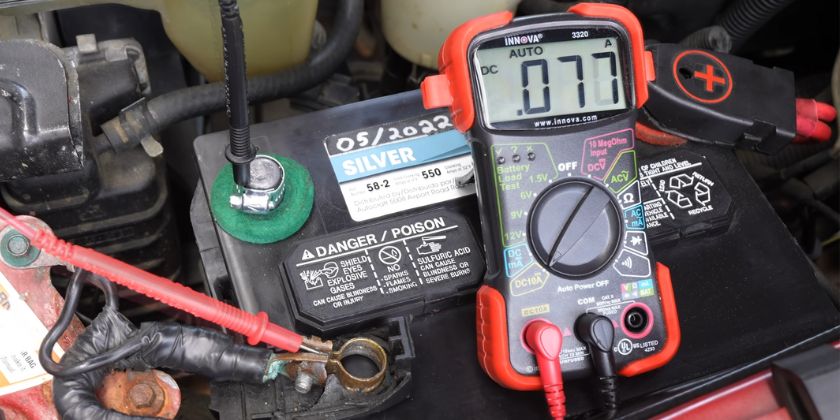
If you’re getting a low voltage even with clean terminal connections, it’s possible that there’s some electrical component drawing power from the battery when the engine is off.
This phenomenon is called a parasitic draw.
To check whether that’s happening in your vehicle or not, follow these steps:
- Recharge the battery through a charger or jump-start (and drive) the vehicle.
- Once the battery is charged, turn off the vehicle, take the key out of the ignition, and all accessories, such as radio, lights, A/C, etc.
- If your vehicle has a keyless entry system, move the fob away from the vehicle.
- Set the multimeter to Amp mode.
- Plug the positive multimeter lead into the amp port on the multimeter while keeping the negative lead as it is.
- Disconnect the negative battery cable from its terminal.
- Connect the negative multimeter probe to the negative battery cable and the positive probe to the negative battery terminal. The reading should be 0.5-0.7 Amps.
If it’s 1 Amp or higher, a car component is drawing some power from the battery.
To find out exactly which component it is, pull out different fuses one by one while monitoring the multimeter readings.
If you pull out a fuse and the multimeter reading drops, it indicates that the component corresponding to that fuse is drawing power from the battery.
6. Check the Alternator
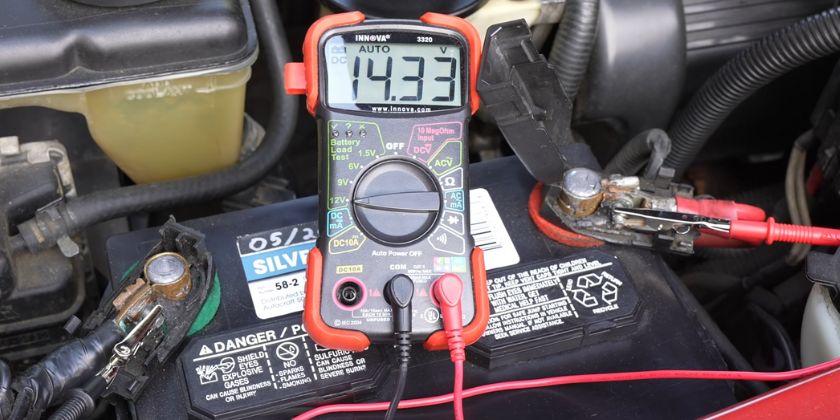
Sometimes, the battery’s voltage level gets low because the alternator is faulty and is not able to charge the battery when the engine is running.
As a result, the battery will go weak, and you’ll get the System Off To Save Battery message from the BMS.
When the engine is running and the vehicle accessories (such as radio and A/C) are turned off, you should get a 13.6V-14.6V reading.
Anything lower than 13.6V means either the alternator is dying or the wire that runs between the alternator and the battery is damaged.
7. Replace The Battery
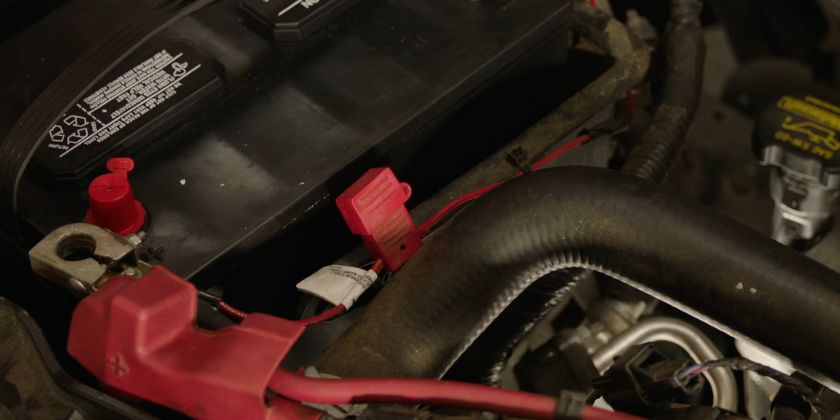
At this point, we’ve confirmed that the alternator is working well, and there’s no parasitic draw causing the voltage level to drop, which leaves us with the last possibility: an aging battery.
As a car battery ages, its internal components undergo wear and tear.
Chemical reactions within the battery, which are crucial for storing and releasing electrical energy, become less efficient.
This leads to a gradual reduction in the battery’s ability to hold a charge and you get the System Off To Save Battery message by the BMS.
In such a case, the best solution is to replace the battery, as it’s on its last legs and can stop working anytime.
Frequently Asked Questions
Why Does My Ford Truck Say System Off To Save Battery?
The System Off To Save Battery message means that the Battery Monitoring System is shutting down the vehicle to save the battery from draining completely.
What is The Battery Saver Mode on the Ford F-150?
The battery save mode is a feature to prevent the battery power (while the engine is off) from getting critically low so that you can start the vehicle next time without any issues.
What Does Battery Saver Audio Off Mean in Ford Fusion?
The ‘battery saver, audio off’ message means the audio system was putting too much load on the battery, which caused the ECU to turn it off.
How to Avoid the System Off To Save Battery Warning in the Future?
One of the biggest reasons for low voltage on car batteries is frequent short trips.
A car battery loses a good chunk of power when energizing the starter motor.
Therefore, when you start the vehicle, drive for at least 30-40 minutes so that the alternator has enough time to recharge the battery.
Otherwise, the battery will not have enough power to energize the starter motor next time.
Other than that, you can also upgrade to a beefier aftermarket battery, as it will have more electrical power for your vehicle systems.
Can You Jumpstart a Car with a Bad Alternator?
Yes, you can jumpstart a car with a bad alternator.
But doing so will not do any help as the alternator won’t be able to charge the battery while the engine is running. As a result, the battery will eventually drain, and the vehicle will stop.

